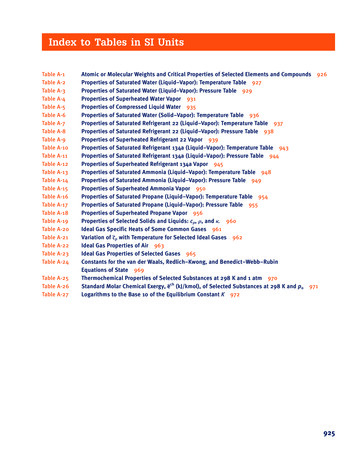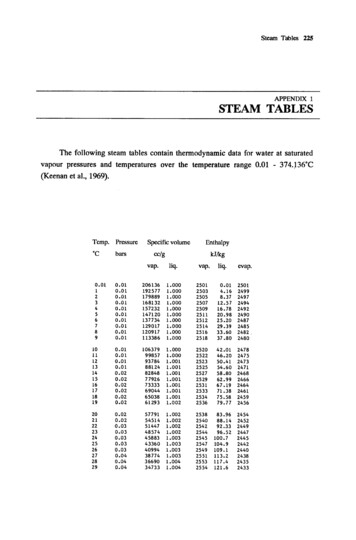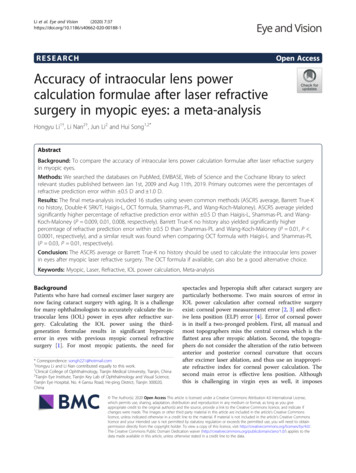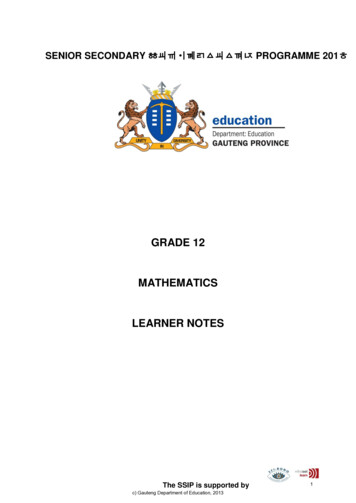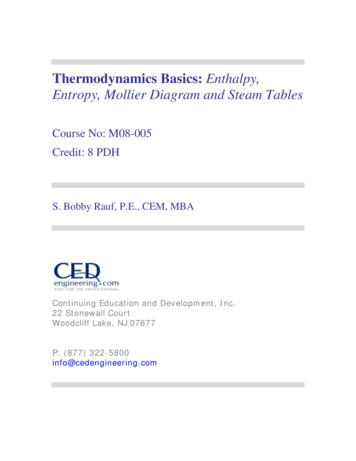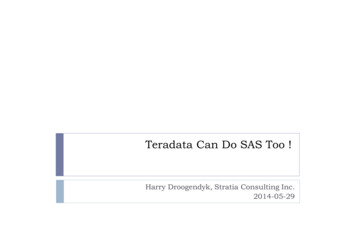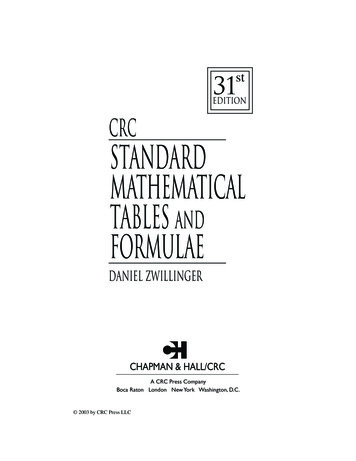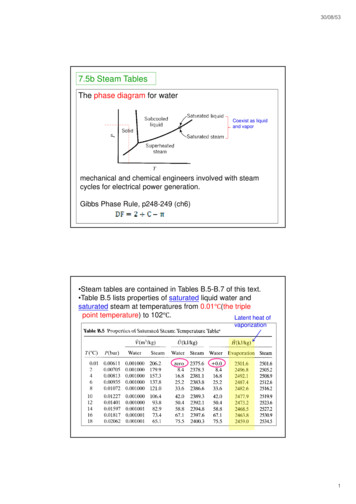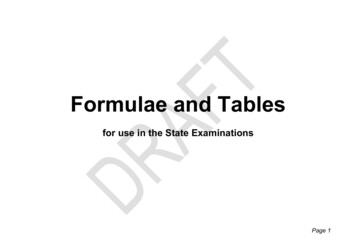
Transcription
Formulae and Tablesfor use in the State ExaminationsPage 1
Draft for consultationObservations are invited on this draft booklet ofFormulae and Tables, which is intended to replacethe Mathematics Tables for use in the stateexaminations.In 2007, the State Examinations Commissionconvened a working group to review and update theMathematics Tables booklet, which is provided tocandidates for use in the state examinations. TheDepartment of Education and Science and theNational Council for Curriculum and Assessment arerepresented on the working group.The group has carried out some consultation and nowpresents this draft for wider consultation.This draft is available in English only. The finalbooklet will be provided in both Irish and English.Anyone receiving this document should note its draftstatus, and should not assume that content currentlyin the draft will be included in the final version. Thefinal version will be circulated to all schools inadvance of its introduction in the state examinations.The working group recognises that the MathematicsTables booklet is used by other institutions in theirown examinations and by various individuals forother purposes. Whereas the needs of such users willbe noted, final decisions will be taken in the contextof the booklet’s primary purpose as a reference forcandidates taking examinations conducted by theState Examinations Commission.Comments should be forwarded by e-mail totables@examinations.ie before 31 May 2008.Page 2
ContentsLength and area .4Surface area and volume.5Area approximations.6Trigonometry .7Co-ordinate geometry .10Geometry .11Algebra .12Sequences and series .12Number sets – notation .13Calculus .14Financial mathematics .16Statistics and probability.18Units of measurement .26Common quantities, their symbols and units of measurement .28Frequently used constants.33Particle physics .34Mechanics.36Heat and temperature.41Waves .41Electricity.43Modern physics.45Electrical circuit symbols .46The elements.51.Page 3
Length and areaParallelogrambhCArc / SectorTrianglecθhraPerimeter 2a 2bArea ah ab sin CWhen θ is in radians:Length of arc rθCircle / DiscArea of sector rLength of circle 2 π rArea of disc πr 212r 2θaPerimeter a b cArea 12ah 12ab sin CWhen θ is in degrees: θ Length of arc 2 π r 360 θ 360 Area of sector π r 2 b Cs ( s a)( s b)( s c) ,where s a b c.2Page 4
Surface area and volumeCylinderSphereSolid of uniform cross-section(prism)rrhhCurved surface area 2 π rhVolume π r 2 hASurface area 4 π r 2Volume 43πrVolume Ah , where A is thearea of the base.2Pyramid on any baseConeFrustum of a conelhr13πr 2 hhRCurved surface area π rlVolume hrVolume 13(2π h R Rr rA2)Volume 13Ah , where A is thearea of the base.Page 5
Area approximationsTrapezoidal rule:Area h[ y1 y n 2( y 2 y3 y 4 L y n 1 )]2or h[first last twice the rest ]2y1y2y3y4 ynhSimpson’s rule:Area h[ y1 y n 2( y3 y5 L y n 2 ) 4( y 2 y 4 L y n 1 )] , (where n is odd)3or h[first last twice the odds four times the evens]3Page 6
Trigonometry1Definitionssin Atan A cos A1cot A tan A1sec A cos A1cosec A sin A–1(cos A, sin A)A1–1Trigonometric ratios of certain anglesA (degrees)0 90 180 270 30 45 60 A (radians)0π2π3π2π6cos A10–10π41π312sin A010–1tan A0notdefined0notdefined3212132123213Basic identitiescos 2 A sin 2 A 1cos( A) cos Asin( A) sin Atan( A) tan APage 7
Compound angle formulaeDouble angle formulaecos( A B ) cos A cos B sin A sin Bcos 2 A cos 2 A sin 2 Acos( A B ) cos A cos B sin A sin Bsin 2 A 2 sin A cos Asin( A B ) sin A cos B cos A sin Btan 2 A 2 tan A1 tan 2 Acos 2 A 1 tan 2 A1 tan 2 Asin 2 A 2 tan A1 tan 2 Acos 2 A 12(1 cos 2 A)sin 2 A 12(1 cos 2 A)sin( A B ) sin A cos B cos A sin Btan( A B) tan A tan B1 tan A tan Btan( A B) tan A tan B1 tan A tan BPage 8
Products to sums and differencesTrigonometry of the triangle2 cos A cos B cos( A B) cos( A B )2 sin A cos B sin( A B ) sin( A B )2 sin A sin B cos( A B) cos( A B)cos A cos B 2 cosA BA Bcos22cos A cos B 2 sinA BA Bsin22bArea B2 cos A sin B sin( A B ) sin( A B )Sums and differences to productsAcab sin CCaSine rule:12abc sin A sin B sin CCosine rule: a 2 b 2 c 2 2bc cos AIn a right-angled triangle,A BA Bsin A sin B 2 sincos22sin oppositehypotenuseA BA Bsin A sin B 2 cossin22cos adjacenthypotenusetan oppositeadjacentPage 9
Co-ordinate geometryLineSlope: m Distance y 2 y1x 2 x1( x1 , y1 )( x 2 x1 ) 2 ( y 2 y1 ) 2( x2 , y 2 ) x x 2 y1 y 2 ,Midpoint 1 2 2Equation of a line: y y1 m( x x1 ) or y mx cArea of a triangle with one vertex at the origin 12x1 y 2 x 2 y1 bx ax 2 by1 ay 2 ,Point dividing a line segment in the ratio a : b 1 a b a bDistance from a point to a line ax1 by1 ca2 b2Page 10
CircleEquation of a circle, centre (h, k ) , radius r: ( x h) 2 ( y k ) 2 r 2Circle x 2 y 2 2 gx 2 fy c 0 has centre ( g , f ) and radiusTangent to circle through given point:g2 f 2 c( x h)( x1 h) ( y k )( y1 k ) r 2 orxx1 yy1 g ( x x1 ) f ( y y1 ) c 0GeometryNotationLine through A and B:ABVector operationsv 1 x1i y1 j , v 2 x 2 i y 2 jLine segment from A to B:ABScalar product:Distance from A to B:ABVector from A to B:ABVector from origin O to A:OA av 1 v 2 x1 x 2 y1 y 2 v 1 v 2 cos θNorm:v x2 y2Page 11
AlgebraRoots of quadratic equation: x b b 2 4ac2anBinomial theorem: ( x y ) n r 0 n n r r n n n n 1 n n n x y x x y x n 2 y 2 L x n r y r L y n r 0 1 2 r n De Moivre’s theorem: [r (cos θ i sin θ )] r n (cos nθ i sin nθ ) r n e inθ or (r cis θ ) r n cis(nθ )n a b :Inverse of matrix A c d n1 d b , where det A ad bcdet A c a Sequences and seriesArithmetic sequence or seriesTn a (n 1)dSn n[2a (n 1)d ]2Geometric sequence or seriesTn ar n 1Sn a (1 r n )1 rS a, where r 11 rPage 12
Number sets – notationNatural numbers:Whole numbers:Integers:Rational numbers:Real numbers:Complex numbers:N {1, 2, 3, 4, L}W {0, 1, 2, 3, 4, L}Z {L 3, 2, 1, 0, 1, 2, 3, L} p p Z, q Z , q 0 Q q RC a bi a R, b R, i 2 1{}Page 13
CalculusDifferentiationf (x)f ′(x)xnexnx n 11xexe axae axaxcos xa x ln a sin xsin xcos xtan xsec 2 x1ln xcos 1xaxaxtan 1asin 1 2a x1a2 x2a2a x2Product ruley uv Quotient ruledydvdu u vdxdxdxuy v dy dxvdudv udxdx2vChain ruley u (v( x)) dy du dv dx dv dxNewton-Raphson Iterationf ( xn )x n 1 x n f ′( x n )Maclaurin series2f ( x) f (0) f ′(0) x f ′′(0) 2f ( r ) ( 0) rx L x Lr!2!Taylor seriesf ( x h) f ( x) hf ′( x) h2hrf ′′( x) L f2!r!(r )( x) LPage 14
IntegrationConstants of integration omitted.Integration by partsf (x) f ( x)dxx n , (n 1)x n 1n 11xexln xcos xsin x cos xtan xln sec xa x (a 0)12a x12x a22(a 0)(a 0)sin 1Solid of revolution about x-axisVolume ex1 axeaaxln asin xe ax udv uv vdu x bπ y 2 dxx axa1xtan 1aaPage 15
Financial mathematicsIn all of the following, t is the time in years and i is annual rate of interest, depreciation or growth, expressed as adecimal or fraction (so that, for example, i 0·08 represents a rate of 8%)1.Compound interest: F P(1 i )tPresent value: P F(1 i )t(F final value. P principal)(F final value. P present value)Depreciation – reducing balance method: F P(1 i )t(P initial value. F later value.)Depreciation – straight line method: Annual depreciation initial cost residual valueuseful economic lifeAmortisation (mortgages and loans – equal repayments at equal intervals):R A1i (1 i ) t(1 i ) t 1(R repayment amount, A amount advanced)The formulae also apply when compounding at equal intervals other than years. In such cases, t is measured in the relevantperiods of time, and i is the period rate.Page 16
Annual percentage rate (APR) – statutory formulaThe APR is the value of i (expressed as a percentage) for which the sum of the present values of all advances isequal to the sum of the present values of all repayments. That is, the value of i for which the following equationholds:k M k 1Ak (1 i )Tkj mRj (1 i)j 1tjwhere:M is the number of advancesAk is the amount of advance kTk is the time in years from the relevant date to advance km is the number of repaymentsRj is the amount of repayment jtj is the time in years from the relevant date to instalment j.Converting period rate to APR/AERi (1 r ) m 1where:i is the APR or AER (expressed as a decimal)r is the period rate (expressed as a decimal)m is the number of periods in one year.Page 17
Statistics and probabilityMeanFrom list: μ ΣxnFrom frequency table: μ The standard error of the mean isΣfxΣfFrom list: σ Σ( x μ ) 2nFrom frequency table: σ Σf ( x μ ) 2ΣfSamplingThe sample mean x is an unbiased estimator of thepopulation mean μ. The adjusted sample standardΣ( x μ ) 2is an unbiased estimatordeviation s n 1of the population standard deviation σ.nstandard error of the proportion isHypothesis testingTukey quick test:Significance levelCritical value of tail-countStandard deviationσt-test:t χ -test:2pq.n1%100.1%13X μ s n k25%7and theχ i 1(Oi E i ) 2EiPage 18
Probability distributionsBinomial distribution: n P (r ) p r q n r r μ npBinomial coefficients n nn! C r C (n, r ) r!(n r )! r nSome values of C r :σ npqnPoisson distribution:P(r ) e λλrr!μ λ, λ npσ λNormal (Gaussian) distribution:f ( x) 1σ 2πe ( x μ )22σ 2Standard normal distribution:11 2 z2f ( z) e2πx μStandardising formula: z 500564356435Page 19
Area under the standard normal curveP ( z z1 ) 12π z1 1 z 2e 2 dz -3-2-101 z 8853185548577859986213Page 20
Area under the standard normal curve 990Page 21
Chi-squared distribution – inverse valuesThe table gives the value of k corresponding to theindicated area A.That is, given a required probability A, the table givesthe value of k for which P χ 2 k A .(Degrees ofA 31·319Page 22
Chi-squared distribution – inverse values (continued)Degrees ofA 091·952104·21116·32128·30140·17Page 23
Student’s t-distribution – two-tailed inverse valuesThe table gives the value of k corresponding to the indicated area Ain the two tails of the distribution.A2That is, the table gives the value of k for which P ( t k ) A .degrees offreedomA2-kkSignificance �0734·8805·239Page 24
Student’s t-distribution – two-tailed inverse values (continued)Significance leveldegrees 614·0954·054 �891Page 25
Units of measurementBase unitsThe International System of Units (Système International d’Unités) is founded on seven base quantities,which are assumed to be mutually independent. These base units are:Base quantitySI base unitSymbol for unitlength (l)metremmass (m)kilogramkgtime (t)secondselectric current (I)ampereAtemperature (T)kelvinKamount of substance (n)molemolluminous intensitycandelacdPage 26
PrefixesPrefixes are used to form decimal multiples and submultiples of SI units. The common prefixes todekada1010The symbol for a prefix is combined with the unit symbol to which it is attached to form a new unit symbol,e.g. kilometre (km), milligram (mg), microsecond (μs).Page 27
Common quantities, their symbols and units of measurementQuantitySymbolSI unitSymbol forSI unitNon-SI unit usedabsorbed doseDgrayGy J kg–1accelerationametre per second squaredm s–2acc. due to gravitygmetre per second squaredm s–2activityAbecquerelBqamount of egree (º)minute (')second ('')angular velocityωradian per secondrad s–1rpmareaAmetre squaredm2are (a) 100 m2hectare (ha) 100 a 10 000 m2atomic numberZcapacitanceCfaradF C V–1chargeqcoulombC AsPage 28
QuantitySymbol forSI unitNon-SI unit usedmole per litremol l–1ppm; %(w/v), %(v/v)g cm–3SymbolSI unitconcentrationccritical angleCdensityρkilogram per metre cubedkg m–3displacementsmetremdose equivalentHsievertSv J kg–1electric currentIampereAelectric field strengthEvolt per metreV m–1 N C–1electronic chargeecoulombC Asenergy (electrical)WjouleJ Nmenergy (heat)QjouleJenergy (kinetic)EkjouleJenergy (potential)EpjouleJjouleJenergy (food)enthalpyhjouleJfocal lengthfmetremforceFnewtonN kg m s–2kW hkcal 4182 J 1 CalPage 29
QuantitySymbolfrequencyfSI unitSymbol forSI unithertzHz s–1half-lifeT1/2secondslength (distance)l, smetremmagnetic fluxΦweberWbmagnetic flux densityBteslaT Wb m–2magnificationmmassmkilogramkgmass numberAmole per litremol l–1molaritymoment of a forceMnewton metreNmmoment of inertiaIkilogram metre squaredkg m2momentumpkilogram metre per secondkg m s–1permittivityεfarad per metreF m–1periodic timeTsecondspowerPwattW J s–1pascalPa N m–2pressureP, pNon-SI unit usedtonne (t) 1000 kgbar 105 PaPage 30
QuantitySymbolSI unitSymbol forSI unitrefractive indexnresistanceRohmΩ V A–1resistivityρohm metreΩmmetre per secondm s–1watt per metre squaredW m–2speedsound intensitysound intensity levelu, vIknot 0.514 m s–1bel (1 B 10 dB)I.L.specific heat capacitycstrainεstressNon-SI unit used–1–1joule per kilogram per kelvinJ kg KσNewton per metre squaredPa N m –2temperatureTkelvinKtemperaturet, θdegree Celsius Cchange in temperatureΔθkelvinKtensionTnewtonNthermal conductivitykwatt per metre per kelvinW m–1 K–1Page 31
QuantitySymbolSI unitSymbol forSI unittimetsecondstorqueTnewton metreNmmetre per secondm s–1voltV J C–1watt per metre squared perkelvinW m–2 K–1velocityvoltagepotential differenceu, vVU-valuevolumeVmetre cubedm3wavelengthλmetremweightWnewtonN kg m s–2workWjouleJ NmYoung’s modulusENewton per metre squaredPa N m –2Non-SI unit usedminute (min)day (d)hour (h)year (y)litre (l) 1000 cm3Page 32
Frequently used constantsConstantalpha particle massAvogadro constantBoltzmann constantelectron masselectron voltelectronic chargeFaraday constantgravitational constantneutron masspermeability of free spaceSymbolmαNAkmeeVeFGmnμ0permittivity of free spaceε0Planck constantproton massproton-electron mass ratiospeed of light in vacuohmpmp/mec, c0universal gas constantRValue6.644 6565 10–27 kg6.022 1415 1023 mol–11.380 6505 10–23 J K–19.109 3826 10–31 kg1.602 176 53 10–19 J1.602 176 53 10–19 C96 485.3383 C mol–16.6742 10–11 m3 kg–1 s–21.674 927 28 10–27 kg4π 10–7 N A–28.854 187 817 10–12 F m–16.626 0693 10–34 J s1.672 621 71 10–27 kg1836.182 672 162.997 924 58 108 m s–18.314 472 J K–1 mol–1Page 33
Particle bleneutrinomuontaupi meson(mass of electron 1) 10 μ μ– – –τ τπ π2073500πoMesonsBaryonsMassName –oMean lifeYear ofdiscovery18971956–62 10 s–121 10s–8193719752732.6 10 s19472648.4 10–17 s1947?1947K mesonK K K 970protonp1836 1032 y1897neutronn1839960 s1932lambdaΛo21832.6 10–10 s1947sigmaΣo2327 10s1953chiΞ Ξ– Ξo2573 10–10 s1954omega Ω––Σ Σ3272 10–10–10s1964Page 34
̄s̄t̄d̄c̄b̄Page 35
MechanicsLinear motion with constant accelerationv u ats ut 2122at2v u 2as u v t 2 s average speed Relative motiondistancetimesbc sb scvbc vb vcabc ab acMomentum of a particlemvNewton’s experimental law (NEL)v1 – v2 – e(u1 – u2)Conservation of momentumm1 u 1 m2 u 2 m1 v 1 m2 v 2Impulse (change in momentum)mv – muPage 36
srAngle in radiansθ Angular velocityω Linear velocity and angular velocityv rωCentripetal accelerationa rω 2 Centripetal forceF mrω Newton’s law of gravitationF Force and accelerationF maWeight and acceleration due to gravityW mg Vρg ;Period of a satelliteT2 Moment of a forceM FdTorque of a coupleT Fdθtv2r2mv 2rGm1m2d2g GMR24π 2 R 3GMPage 37
Centres of gravityHemisphere, radius r38r from centreHemispherical shell, radius r12r from centreRight circular cone14h from the baseTriangular lamina13Arc, radius r, angle 2θSector of disc, radius r, angle 2θ x x 2 x3 y1 y 2 y 3 ,from base along median 1 33 r sin θθ2r sin θ3θMoments of InertiaUniform rod, length 2lCentre:13ml 2 One end:43ml 2Uniform disc, radius rCentre:12mr 2 Diameter:14mr 2Page 38
Uniform hoop, radius rCentre: mr 2 Diameter:Uniform solid sphere, radius rDiameter:Parallel axis theorem2 2mr52I b I c m bcPerpendicular axis theoremIZ I X I yHooke’s lawF – ksSimple harmonic motiona –ωs12mr 22T 1f 2πωs A sin (ω t α )22v ω ( A 2 – s2)Simple pendulumT 2πlgCompound pendulumT 2πImghWorkW Fs FdsPage 39
Potential (gravitational) energyEp mghKinetic energyEk Principle of conservation of mechanical energyEp Ek constantMass-energy equivalenceE mc 2PowerP 12mv 2W Fvtpower output 100Percentage efficiencypower inputYoung’s modulusE σεStressσ FAStrainε ΔllDensityρ mVPage 40
FAPressurep Pressure in a fluidp ρghThrust on an immersed plane surfaceT A pcentroidBoyle’s lawpV constantHeat and temperatureCelsius temperaturet / C T /K – 273.15Energy needed to change temperature E mc θ E C θEnergy needed to change state E ml E LWavesVelocity of a wavec fλDoppler effectf ′ Fundamental frequency of a stretched stringf fcc u1T2lμPage 41
Mirror and lens formula1f 1u 1vvuMagnificationm Power of a lensP Two lenses in contactP P1 P2Refractive indexn n Diffraction grating1fsin ireal depth sin r apparent depth1sin C c1c2nλ d sin θPage 42
ElectricityCoulomb’s lawF q1 q24 πε d 2Electric field strengthE FqPotential differenceV WqOhm’s lawV IRResistivityρ Resistors in seriesR R1 R2Resistors in parallel1R 1RAl1R1 Wheatstone bridgeR 1 R3 R2 R4Joule’s lawP RI 21R2Page 43
Force on a current-carrying conductorF IlBForce on a charged particleF qvBInduced emfE Alternating voltage and currentVrms CapacitanceC qVParallel-plate capacitorC Aε 0dEnergy stored in capacitorW PowerP VIMagnetic fluxΦ BATransformerVi N p Vo N sdΦdt12V02I rms I02CV 2Page 44
Modern physicsEnergy of a photonE hfEinstein’s photoelectric equation2h f Φ mvmaxLaw of radioactive decayA λNHalf-lifeT1 2 Mass-energy equivalence12ln 2λ2E mcPage 45
Electrical circuit symbolsConductorsjunction of conductorsconductors crossing withno connectionSwitchespush-to-make switchpush-to-break switchtwo-way switch(SPDP)dual on-off switch(DPST)normally openon-off switch (SPST)normally closedon-off switch (SPST)dual two-way switch(DPDT)relay(SPST)Page 46
Powercellphotovoltaic cellbatteryd.c. supplya.c. supplytransformerfuseearthvariable resistor(rheostat)preset variable resistorpotential dividerResistorsfixed resistorthermistorlight-dependent resistorPage 47
Capacitorscapacitorelectrolytic capacitor(polarised capacitor)variable capacitorpreset variable capacitor(trimmer)diodeZener diodephotodiodelight-emitting terohmmeteroscilloscopePage 48
Amplificationpnp-junction transistorlight-sensitive transistoramplifier(block oelectric transduceraerial (antenna)filament lampsignal lampneon lampnpn-junction transistorAudioLampsPage 49
Other devicesMmotorheaterinductorinductor withferromagnetic coreANDNOT(inverter)NANDLogic gatesORNORPage 50
The elementsPeriodic table of the SgBhHsMtDsRg(209.0) (210.0) (222.0)116117118Uub Uut* Uuq Uup* Uuh Uus* Uuo(223.0) (226.0) (227.0) (261.1) (262.1) (266.6) (264.1) (277.0) (268.1) (271.0) (272.2) (285.0)(289.0)(289.0)(293.0)* These elements have not yet been detected (2008).See page 54 for the Lanthanoid and the Actinoid Series.Page 51
First ionisation energies of the elements(in kJ .0870.0890.11007589.4715.6703.0812.1890 6117118FrRaAcRfD
sin 2 cos cos 2sin A B A B A B 2 cos 2 sin sin 2sin A B A B A B 2 sin 2 sin sin 2cos A B A B A B Trigonometry of the triangle c 1 Sine rule: C c B b A a sin sin sin Cosine rule: a b2 c 2bccos A In a right-angled triangle, hypotenuse opposite sin

